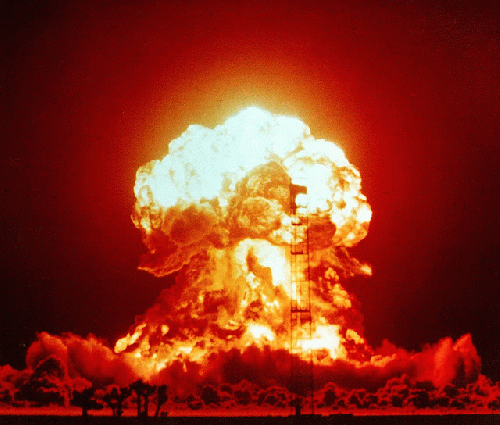
The United States is in the process of creating the conditions for a nuclear war with Russia and the Russian president is calmly talking about global annihilation if such an event transpires
(Image by truthdig.com) Details DMCA
Late last month, the Bulletin of the Atomic Scientists unveiled its "Doomsday Clock" for the 26th time since its creation in 1947, declaring that the hands on the clock would remain where they had been at the last setting, in 2018. Rachel Bronson, the bulletin's president, described the environment in which the bulletin assesses the threats faced by the world today (which have expanded beyond nuclear to include climate change and cyber) as the "new abnormal," and noted that no one should take comfort from the fact that the hands of the clock have not moved.
"This new abnormal," Bronson wrote in her statement explaining the decision, "is a pernicious and dangerous departure from the time when the United States sought a leadership role in designing and supporting global agreements that advanced a safer and healthier planet. The new abnormal describes a moment in which fact is becoming indistinguishable from fiction, undermining our very abilities to develop and apply solutions to the big problems of our time."
William Perry, former secretary of defense under President Bill Clinton, helped unveil the 2019 iteration of the Doomsday Clock. In his remarks, he highlighted President Donald Trump's declaration to withdraw from the landmark 1987 Intermediate-Range Nuclear Forces (INF) Treaty as an indication of the collapsing relationship between the U.S. and Russia. "When you withdraw from treaties, you are losing this important vehicle of dialogue," Perry observed. "My own judgment is, relative to a year ago, we are slightly worse off."
I agree with Perry the world is worse off today than it was a year ago. I disagree, however, with his use of the word "slightly" to describe the situation we face, and I dissent from the bulletin's decision to stay the hands of the Doomsday Clock. Humanity is sleepwalking toward global annihilation, furthered by a collective amnesia about the threat posed by nuclear weapons, especially in an environment void of meaningful arms control. On Feb. 2, the United States suspended its obligations under the INF Treaty, beginning a 180-day process that, once concluded, will lead to the abandonment of that agreement. Russia soon followed suit. The death of the INF Treaty represents far more than simply the end of an era. It is the end of a process and mindset that recognized nuclear weapons for their globe-killing reality and sought their reduction and eventual elimination.
The danger of nuclear weapons has always been at the center of the Doomsday Clock. According to its mission statement, the Bulletin of the Atomic Scientists was founded in 1945 by Manhattan Project scientists who "could not remain aloof to the consequences of their work." Two years later, in 1947, the bulletin unveiled its iconic clock, the hands of which were ominously set to seven minutes before midnight. "The Bulletin's clock," the late Eugene Rabinowitch, one of the bulletin's founding editors, noted, "is not a gauge to register the ups and downs of the international power struggle; it is intended to reflect basic changes in the level of continuous danger in which mankind lives in the nuclear age, and will continue living, until society adjusts its basic attitudes and institutions."
In 1953, the Soviet Union acquired the hydrogen bomb. That act, on the back of the Korean War, caused the bulletin to ruminate about the unrestrained development of nuclear weapons and the lack of any meaningful arms control efforts to hold nuclear proliferation in check, and prompted it to move the hands of the Doomsday Clock to two minutes before midnight.
Since then, the hands of the Doomsday Clock have been moved back and forth on numerous occasions; retreats were due largely to arms control efforts undertaken by the major nuclear powers and advances due to the failures of these efforts to achieve any lasting change. At the height of the Cold War, in 1984, with the U.S. and the Soviet Union locked in a massive arms race, the Doomsday Clock's hands were moved to three minutes past midnight; in 1988, in recognition of the INF Treaty, the hands were moved back to six minutes, then further to 10 minutes in 1990, marking the end of the Cold War, and to 17 minutes in 1994, on the occasion of the Strategic Arms Reduction Treaty (START). The common denominator in this retrograde movement (which, in the context of the meaning of "midnight," is a good thing) was the embrace of meaningful arms control and the calming effect it had on relationships between nations.
Within three years, the optimism that prompted the bulletin to move the hands of the Doomsday Clock back began to falter; the failure of the U.S. and Russia to conclude the START 3 treaty and the expansion of NATO moved the hands to 14 minutes in 1994, while the nuclear tests conducted by India and Pakistan in 1998 caused the bulletin to advance a further five minutes, to nine minutes (its largest forward move since 1968, when nuclear tests by France and China produced a similar result). The demise of the Anti-Ballistic Missile (ABM) Treaty in 2002 moved the hands to seven; the failure of the nonproliferation treaty in the context of North Korea and Iran pushed them to five in 2007. The election of President Barack Obama injected rare optimism at the bulletin, which moved the hands of the clock back to six minutes in 2010. But his administration's failure to ratify the Comprehensive Test Ban Treaty in 2014 brought the hands back to five minutes, and the election of Donald Trump caused the hands to be moved to 2.5 minutes. The failure of the U.S. and Russia to return to the arms control negotiating table brought the hands to their current position in 2018 two minutes before midnight.
The demise of the INF Treaty is symptomatic of a larger problem. The collapse of arms control as an institution. Viktor Mizin, one of the Soviet negotiators involved in the INF Treaty, made note of this reality, and its consequences. "[Soviet arms control negotiators] got their start with the first negotiations for the partial test-ban treaties [in the 1950s]. These were the people with whom the partial [U.S.-Soviet] detente and the idea of peaceful coexistence began " [t]his was an entire generation of brilliant diplomats, soldiers, and defense industry specialists. It's no coincidence that most competent people around then were the ones who participated in all these negotiations "we don't have anyone like them now. Both here and in America, there's been a collapse of institutional memory, and no one remembers what happened at these negotiations, and there's nobody who has the same negotiating skills." Worse, Mizin noted, "We're absolutely failing to raise the next generation."
The INF Treaty grew out of an idea"double zero"put forward in 1982 by President Reagan in a speech at his alma mater, Eureka College. The ideas presented in the speech were the brainchild of Richard Perle, the arch conservative assistant secretary of defense for global strategic affairs. The crux of the proposition made by Reagan was that the Soviet Union would eliminate the totality of its SS-20 intermediate-range missile force. The SS-20 was a new road-mobile missile armed with three 750-kiloton nuclear warheads, and its deployment in 1976 was seen by the U.S. and NATO as a game-changer. In exchange for the Soviets agreeing to eliminate these weapons, the U.S. would forego the deployment of two missiles the Pershing II and the Ground Launched Cruise Missile that were still under development. In short, the U.S. position was that the Soviet Union would get rid of more than 1,400 missiles, while the U.S. got rid of nothing. That proposal, according to Thomas Graham, a senior U.S. arms control official at the time, "was seen as impossible and ridiculous."
Converting the "impossible and ridiculous" into reality was the job of a team of negotiators led by two experienced U.S. diplomats Paul Nitze and Maynard Glitman. Nitze, best known as the architect of America's Cold War policy of containment of the Soviet Union, was a member of the first Strategic Arms Limitation Treaty (SALT I) delegation, considered the most distinguished negotiating delegation the U.S. has ever fielded. This experience served him well during his tenure as chief INF negotiator. In an effort to break the impasse created by the American "Zero Option" position, Nitze undertook his now famous "walk in the woods" with his Soviet counterpart, Yuliy Kvitinsky, where the two, on their own, agreed to a disarmament formula that would reduce the threat posed by the INF systems. Reagan was initially supportive of Nitze's proposal but backtracked when Richard Perle vehemently objected. "The trouble with you," Perle told Nitze afterward, "is you are just an inveterate problem solver."
In 1983, the Soviets walked out of the INF talks, frustrated at the lack of progress being made. Three years later, after the ascension of Mikhail Gorbachev as leader of the Soviet Union, the talks resumed, this time led by Glitman, who had been Nitze's deputy during the first round of talks from 1981 to 1983. Glitman proved a steady, sobering presence, and by the end of 1987 had negotiated a treaty that saw the elimination of all U.S. and Soviet INF weapons a true "Zero Option" (Perle, who opposed the INF Treaty, resigned in protest).
The INF Treaty has gone through its fair share of trials and tribulations. As one of the first U.S. inspectors assigned to monitor the Votkinsk missile plant in the Soviet Union, where SS-20 missiles had been assembled, I was involved in helping turn back the efforts of such conservative lawmakers as Sen. Jesse Helms, who sought to use delays in the implementation of inspection procedures at Votkinsk as an excuse to kill the treaty. That these delays were brought on by shortcomings on the American side were of no moment to Helms and his allies. Fortunately, sober minds prevailed, and the inspections were conducted in total conformity with the treaty.
The 2002 decision by the U.S. to withdraw from another foundational arms control agreement the ABM Treaty stoked frustration inside Russia over what it viewed as the unbalanced nature of the INF Treaty, which prohibited its possession of intermediate-range missiles while the U.S. expanded NATO and fielded missile defense systems in Europe, and other nations, such as China, India and Pakistan, were allowed to develop INF-capable systems without restriction. Russian President Vladimir Putin gave voice to these concerns in 2007, saying, "We need other international participants to assume the same obligations which have been assumed by the Russian Federation and the US."
(Note: You can view every article as one long page if you sign up as an Advocate Member, or higher).





